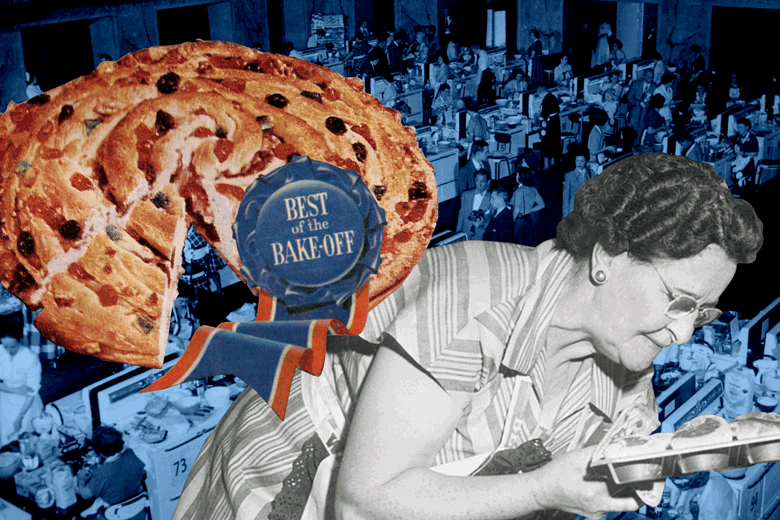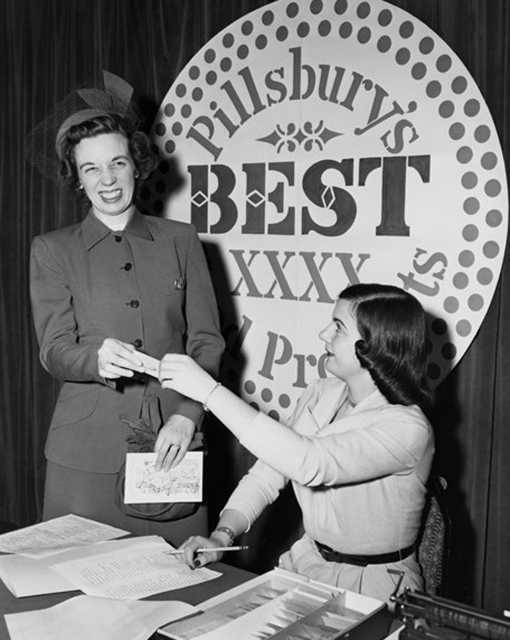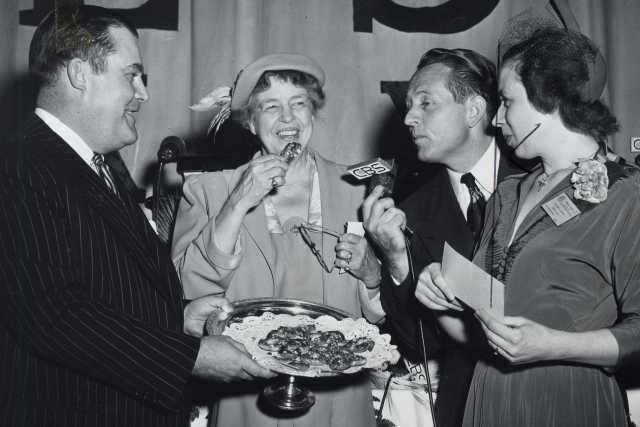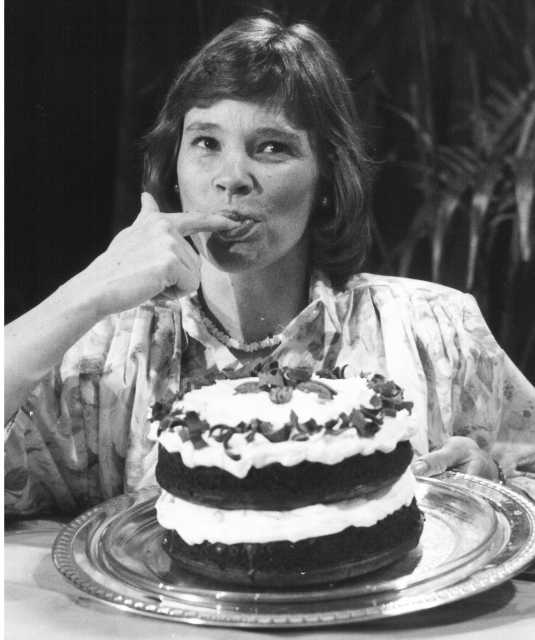
The Grand National Recipe and Baking Contest, the competition that became known as the Pillsbury Bake-Off, paved the way for today’s cooking reality shows and reshaped the American recipe book.
Nora Ephron described the Pillsbury Bake-Off in a 1973 essay for Esquire as “like being locked overnight in a bakery—a very bad bakery.” Inside the glitzy Beverly Hilton hotel in Los Angeles, she shadowed the 100 finalists on the floor of the 24th Annual Bake-Off, portraying contestants as small-town simpletons of dubious culinary aptitude. The acerbic Ephron was never known for spinning sugar just to make candy, so it wasn’t surprising that she found these prize-winning confections so pedestrian.
She conceals neither her disdain for the spectacle nor her prejudices as a big-city food snob. “None of the recipes seemed to contain one cup of sugar when two would do,” Ephron writes, “or a delicate cheese when Kraft American would do, or an actual minced onion when instant minced onions would do.” She presents the Bake-Off as a Miss America pageant for devoted, Tupperware-loving housewives and a symbol of the regressive stereotype that women belong in the kitchen.
But Ephron’s critique glazes over the Bake-Off’s rich contribution to American culinary history—particularly how recipes originating in the competition inspired innovation in home kitchens and impacted trends in American baking for almost 75 years. The Bake-Off foreshadowed our global obsession with reality TV cooking competitions like Top Chef and Cake Wars and influenced today’s time-saving recipe “hacks” that prioritize fewer steps and greater convenience. Over the years, many notable food personalities, magazine editors, and tastemakers have judged the Bake-Off and impacted its legacy, including Leah Chase, Laurie Ochoa, Tom Sietsema, and Carolyn Jung.
Historically, the Bake-Off has been shaped by trends in baking and home economics, but it’s also shaped those trends. In 1966, Ella Helfrich’s runner-up Tunnel of Fudge Cake—a chocolate Bundt cake filled with a core of oozing chocolate frosting—was so popular that it created massive demand for Bundt pans, then manufactured by only one company, the Minnesota-based Nordic Ware. When Dorothy Koteen’s Open Sesame Pie took home the top prize in 1954, it set off a nationwide shortage of sesame seeds, an uncommon ingredient in American grocery stores at the time.
The Pillsbury Bake-Off was the brainchild of Leo Burnett and his Chicago-based advertising agency, designed to commemorate the company’s 80th anniversary by soliciting recipes that would be included inside bags of Pillsbury Best flour. In his book American Cuisine: And How It Got This Way, Yale historian and author Paul Freedman cites the Bake-Off as “an early example of the ability of corporations and the media to attract interest in food competition, an innovation later dramatically exploited by the Food Network, beginning with the first Iron Chef broadcasts in 2005.” The Bake-Off was intermittently televised going back to the early 1950s—although never presented with the cutthroat tenor of today’s suspense-filled cooking battles—featuring hosts like Arthur Godfrey, Bob Barker, Alex Trebek, and Phylicia Rashad.
When the contest debuted as the Grand National Recipe and Baking Contest in 1949, it was a broad cultural moment. The event was ornately staged in a massive ballroom inside the Waldorf-Astoria hotel retrofitted with 100 General Electric ovens. To generate power for so many appliances, organizers had to drill underground to divert electricity from the New York City subway system. Former first lady Eleanor Roosevelt presented a $50,000 check (over $600,000 in today’s currency) to Theodora Smafield of Detroit for her No-Knead Water-Rising Twists, braided breakfast rolls that leavened in a water bath. Contest rules at the inaugural event incentivized finalists to use Pillsbury Best by offering to double the $25,000 grand prize if they submitted a seal from the bag of flour they used in their winning recipe (which Smafield gladly did).
Many iconic American dessert recipes owe their origins to the Bake-Off. In 1951, Betty Cooper’s French Silk Chocolate Pie—a flaky pie crust filled with a no-bake chocolate mousse, whipped cream, and chocolate shavings—won “Best in Class” in the Third Annual Bake-Off. Freda Smith’s Peanut Blossoms from the Ninth Annual Bake-Off in 1957—the ubiquitous thumbprint cookies studded with Hershey’s Kisses—are a staple on every holiday cookie plate, even though Smith won a mere $100 and finished in third place that year.
According to Megan Elias, the director of gastronomy at Boston University, quirky recipe names like Orange Kiss-Me Cake (a bitter orange coffee cake with raisins and walnuts), City Slicker Chickerole (a creamy chicken casserole baked inside a tomato-flavored crust), and Hot Ziggities (ground hot dogs tucked inside a pastry jacket) were commonly used during the postwar period to appeal to women who entered the workforce during wartime. “The ’50s in particular were a time for cookbooks to push the idea of food as fun,” says Elias. “Part of that is gender retrenchment, in order to get women back into the kitchen.”
Until then, women could only be recognized publicly for their baking prowess through local events like state fairs and church picnics. A national contest provided a rare opportunity for women to demonstrate their skills on a grander stage, albeit in a realm they’d been pigeonholed into forever. “The message behind the Bake-Off was that you can achieve greatness, but only in the arena that we all know is yours anyway,” says Elias. “In other words, you can make great cakes, but please do not invent things or earn more money than your husband.” As was conventional at the time, winners like Betty Cooper were routinely referred to by their husband’s full name (Mrs. Kendall E. Cooper), a sobering reminder that a woman was defined by her marriage, not her pastry skills.
In the early years of the competition, recipes were required to include at least 1/2 cup of Pillsbury flour. But by the mid-1960s, the emergence of powdered mixes and refrigerated dough products shifted the focus away from scratch cooking and toward convenience. To highlight these ready-made ingredients, Pillsbury themed the 1966 contest “The Busy Lady Bake-Off.” Male finalists were a rarity—only three of the 100 finalists in the first Bake-Off in 1949 were men. Kurt Wait became the first male grand prize winner for his Macadamia Fudge Torte recipe in 1996. Somewhat controversially, that was also the first year that Pillsbury increased the grand prize award to $1 million. (There were eleven million-dollar winners between 1996 and 2014.)
After being selected as a finalist for the 47th Bake-Off in Nashville, Mary Beth Protomastro, a retired copyeditor, became so enamored of the event that she published a book about it. In Smart Cookies: How Home Cooks Became Finalists in the Pillsbury Bake-Off Contest, Protomastro presents a counterpoint to Ephron’s unflattering essay, interviewing 27 former Bake-Off finalists whose stories reflect a supportive community of amateur bakers bound together by perseverance, determination, and even good old-fashioned luck. Some contestants spend months perfecting their recipes. Others cobble them together in minutes. Many hopefuls flood the entry portal in the months leading up to the event with as many as 50 different recipes, while some proffer only one or two. Culinary professionals—like chefs, food writers, educators, and recipe developers—are prohibited from entering the Bake-Off. The subjects of Smart Cookies are mothers and grandmothers, successful businesswomen, and retirees. They battle disabilities, severe dietary restrictions, and even cancer to qualify for the finals.
Inside the clandestine world of Pillsbury’s test kitchen, the process of winnowing down submissions to identify the most deserving recipes was arduous. “I probably made eight to nine recipes per day,” says Linda Johnson Larsen, who cross-tested recipes for more than a dozen Bake-Offs while working in the test kitchens on the 28th floor of Pillsbury’s headquarters in Minneapolis from 1987 to 2019. Johnson Larsen, a home economist and the author of 53 cookbooks, describes the vetting process as time-consuming and extremely regimented. “The finished products would be presented to tasting panels made up of all the home economists in the test kitchen. Then there would be a discussion about whether the recipe would move forward.” The most promising entries would undergo “tolerance” tests to measure their resilience with minor tweaks, then be vetted for originality. Before the internet, the test kitchen staff did all the vetting manually, scouring thousands of cookbooks and glossy food magazines to weed out potentially plagiarized material.
Bake-Off scholars insist there’s a science to authoring prizewinning recipes. After General Mills bought Pillsbury in 2001, judges favored dishes that creatively repurposed proprietary convenience products over traditional scratch baking. Protomastro made her Caprese Corn Cakes by reconstituting refrigerated Pillsbury sugar cookie dough with Green Giant frozen corn niblets (both items appeared on the list of sanctioned General Mills products that year) into cornbread, then shaping it into flat discs topped with a mozzarella and tomato salad. “Many of the contestants in my book talk about working backward with prepared products,” says Protomastro. “You have to know how the essential components in a refrigerated crescent roll behave to be able to reverse engineer it and turn it into something else.”
Bake-Offs during the ’70s and ’80s saw an influx of healthier ingredients like oatmeal and granola, along with the advent of the microwave, an appliance that Ephron regards with a mix of skepticism and contempt. In the early 1990s, Johnson Larsen witnessed firsthand how baking trends influenced the thousands of entries that were tested in the Pillsbury kitchens before each contest. “We started seeing recipes that had chiles in chocolate,” she says. “That was really new at the time. White chocolate was also a big deal in the ’90s, and that started at the Bake-Off, too.”
After the 2014 Nashville contest, Pillsbury discontinued the in-person event. Without explanation, the company lowered the prize to $50,000 and the number of finalists down to 20. Future winners would be judged on the merit of their recipes alone. The Bake-Off’s devoted fan base viewed the virtual pivot as a betrayal. Susan Bickta administers a private Facebook group of more than 250 past winners and future hopefuls called the “Pillsbury Bake-Off Wannabes.” Formerly a department store announcer at Hess’s in Allentown, Pennsylvania, Bickta has strong opinions and a voice that commands attention. She began entering the contest herself in 1982, submitting recipes for almost four decades before finally being recognized as a finalist in 2019 for her Tropical Sweet Hawaiian Sticky Biscuits, refrigerated biscuit dough baked like an upside-down cake with macadamia nuts, crushed pineapple, and coconut.
For years, Bickta fantasized about making the Bake-Off finals, but once her dream came true, the virtual format meant there was no longer a physical event to attend. Although her recipe was among the top 20 finishers, she was not chosen as one of the four “Best in Class” finalists that were invited to a televised awards presentation on the Food Network’s show The Kitchen. “I got a Pillsbury apron, a little gold lapel pin, and a Pillsbury Doughboy that giggles when you push on his belly,” Bickta says, with disappointment and a salty edge. “Forty years of sending in recipes, and I have that little Pillsbury Doughboy. I won’t tell you what I’d like to do with him.”
Laurie McKenna was ecstatic when she learned that she’d won last year’s Pillsbury Bake-Off for her Air Fryer Greek Crescent Nachos—submitted to the contest’s first ever “Ovens Off” theme, soliciting recipes foregoing a conventional oven. The $50,000 payout was a nice perk, but she was more excited about family bragging rights. As the youngest of five sisters, all of whom are avid home cooks, McKenna entered the Bake-Off on a lark when her siblings insisted that she join their attempts to win. None of them had ever entered a cooking competition before.
Inspired by a similar dish that a friend served at her book club, McKenna, a corporate trainer from Fairfield, Ohio, ordered an air fryer from Amazon and picked up a few tubes of Pillsbury Crescent Rolls at her local supermarket days before the deadline. After cutting the dough into triangles and crisping them in the air fryer to resemble pita chips, she dusted them with Greek seasoning and topped them with cucumbers, red onions, tomatoes, olives, feta, tzatziki, and fresh dill. When she received the notice that she’d won, McKenna found the biggest rush came from gloating to her sisters. “I thought maybe the Pillsbury Doughboy would arrive at my door with a big cardboard check, but it literally came in a FedEx envelope. There was no fanfare at all.”
Unlike Bickta, McKenna wasn’t bothered by missing out on the in-person event. “I can’t imagine the kind of pressure of having to cook on the spot like that,” she says. I asked if her Bake-Off victory had emboldened her to enter more baking competitions. She has no plans to become an influencer anytime soon. “Everybody keeps asking me that,” she says, “and they also ask if I’m planning to get on TikTok.” According to the contest rules that have been in place since 1966, grand prize winners are forbidden from entering future Bake-Offs. “Now my sisters all want me to help them come up with new recipes,” McKenna says with a giggle. “So they can win it all next year.”


